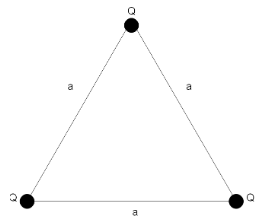
Find the net force for any charge


Answer
558.9k+ views
Hint The force between two charged particles is calculated using the coulomb’s law which quantifies the attraction between two static charged particles. The force is proportional to the product of the charged particles and inversely proportional to the square of the distance between them. Using this formula we can find the net charge of the configuration.
In this solution we will be using the following formula,
Coulomb's law: $F = \dfrac{{k{q_1}{q_2}}}{{{r^2}}}$ where $F$ is the force acting between two charged particles of charge ${q_1}$ and ${q_2}$ which have a distance $r$ between them.
Complete step by step answer
In the diagram given, we can see three charges that are at the corners of an equilateral triangle. We’ve been asked to find the net force on any charge and we can arbitrarily select any charge to find the force since the system is symmetrical and the force experienced by all the 3 charges will be the same.
So, let us select the bottom left charge. From the coulomb’s law, we know that the force between two charges can be written as
$\Rightarrow F = \dfrac{{k{q_1}{q_2}}}{{{r^2}}}$
So, for the bottom left charge, the force it will experience will be due to the other two identical charges which are situated at a distance $a$. So, the net force will be a sum of the forces due to these charges. So, we can write
$\Rightarrow F = \dfrac{{kQQ}}{{{a^2}}} + \dfrac{{kQQ}}{{{a^2}}} $
$\Rightarrow F = \dfrac{{2k{Q^2}}}{{{a^2}}} $
Note
The distance between any two point charges in the length of the line joining the two points which in our case is the length of the side of the triangle which has a length $a$. Since all the charges are identical, the net force experienced by any particle will be repulsive in nature.
In this solution we will be using the following formula,
Coulomb's law: $F = \dfrac{{k{q_1}{q_2}}}{{{r^2}}}$ where $F$ is the force acting between two charged particles of charge ${q_1}$ and ${q_2}$ which have a distance $r$ between them.
Complete step by step answer
In the diagram given, we can see three charges that are at the corners of an equilateral triangle. We’ve been asked to find the net force on any charge and we can arbitrarily select any charge to find the force since the system is symmetrical and the force experienced by all the 3 charges will be the same.
So, let us select the bottom left charge. From the coulomb’s law, we know that the force between two charges can be written as
$\Rightarrow F = \dfrac{{k{q_1}{q_2}}}{{{r^2}}}$
So, for the bottom left charge, the force it will experience will be due to the other two identical charges which are situated at a distance $a$. So, the net force will be a sum of the forces due to these charges. So, we can write
$\Rightarrow F = \dfrac{{kQQ}}{{{a^2}}} + \dfrac{{kQQ}}{{{a^2}}} $
$\Rightarrow F = \dfrac{{2k{Q^2}}}{{{a^2}}} $
Note
The distance between any two point charges in the length of the line joining the two points which in our case is the length of the side of the triangle which has a length $a$. Since all the charges are identical, the net force experienced by any particle will be repulsive in nature.
Recently Updated Pages
A man running at a speed 5 ms is viewed in the side class 12 physics CBSE

The number of solutions in x in 02pi for which sqrt class 12 maths CBSE

State and explain Hardy Weinbergs Principle class 12 biology CBSE

Write any two methods of preparation of phenol Give class 12 chemistry CBSE

Which of the following statements is wrong a Amnion class 12 biology CBSE

Differentiate between action potential and resting class 12 biology CBSE

Trending doubts
What are the major means of transport Explain each class 12 social science CBSE

Which are the Top 10 Largest Countries of the World?

Draw a labelled sketch of the human eye class 12 physics CBSE

How much time does it take to bleed after eating p class 12 biology CBSE

Explain sex determination in humans with line diag class 12 biology CBSE

Explain sex determination in humans with the help of class 12 biology CBSE




